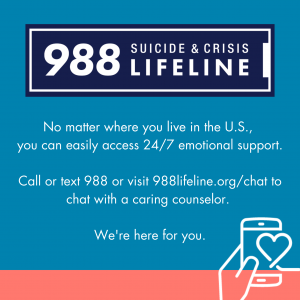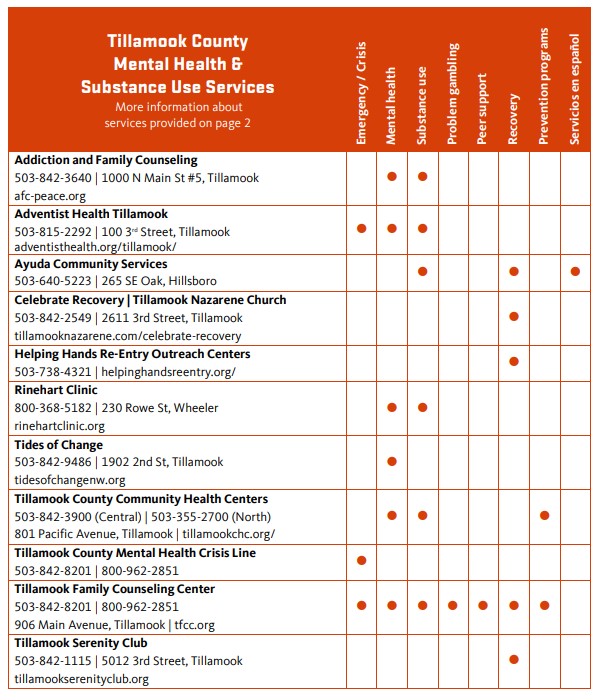By Leanna Coy, FNP-BC
When the Centers for Disease Control and Prevention (CDC) published the statistics on the suicide rates from 2022, the data showed an increase in suicide rates overall. They related this change to the pandemic. Most concerning were the rates of reported suicide deaths among older adults, who showed the largest increase. From 2021 to 2022, the number of suicide deaths in people over age 65 increased by 8.1%. Suicide is a serious public health issue, with older adults having higher suicide rates in almost every country around the world. This should concern everyone in Tillamook County, where 36% of the population is over age 60.
In the United States, older adults comprise 22% of suicide deaths despite being only 16.8% of the population. Of the older adults who attempt suicide, one in four will succeed. This statistic is dramatically different than the youth population rate where the rate is 1 in 200. Why the difference?
- Older adults tend to plan carefully.
- They often use more deadly methods, primarily firearms.
- Older adults are more likely to live alone and less likely to get rescued than younger people.
- Frequently, they are physically frail and less likely to recover from an attempt.
Older adults considering suicide often present with different life perspectives than those at younger age. These perspectives pose an increased risk for their thoughts to turn into actions.
Grief. Older adults are going through the “age of loss,” where they may have lost friends and family members. As they grieve these losses, they may have anxiety regarding their own mortality and begin grieving the end of their life. The loss of family and friends can also lead to social isolation.
Physical health. The number one factor in older adult suicides is physical health. In this age group, 33.5% of suicides relate to changes in their physical health. Many older adults develop chronic illnesses or pain that affects their quality of life. As a chronic condition, older adults may become less fearful when dealing with physical pain.
Autonomy. Challenges with physical health can often lead to losing the ability to care for themselves. In Tillamook County, 15.9% of our older adults live alone. When they face losing their autonomy, it can trigger grief over this loss of freedom and independence. Older adults may develop a sense of burden to others who care for them. They may feel like their caregivers would be better off without them. This is especially true in men.
Cognitive decline. Along with the concern for physical health is the problem of cognitive decline or dementia. The risk for suicide is high among those recently diagnosed with mild cognitive decline or dementia. People with dementia have a 54% increase in suicide during the first year of their diagnosis. With cognitive decline comes the loss of cognitive control and the ability to problem-solve, which can lead to difficulty coping with life’s problems.
Finances. Commonly, older adults live on fixed incomes determined by the presence or lack of retirement savings. Financial concerns may arise when the limited income is stressed. This stress often occurs with increasing medical bills, rising costs for food and basic supplies due to inflation, or money running out due to longevity or lack of savings.
Substance use. Alcohol abuse alone is one of the strongest independent predictors of the risk for suicide death. Alcohol abuse is the second most common factor behind depression. In Medicare beneficiaries, 24% of those with substance use disorder (SUD) have thoughts of suicide. This compares to just 6% of their counterparts who don’t have SUD.
- 7 million Medicare beneficiaries have SUD
- 77% with alcohol dependence
- 16% with prescription drug abuse
- 10% with marijuana use
Of those with SUD, only 11% received treatment for their condition. The factors affecting treatment include a lack of willingness to seek treatment, the cost of treatment, concerns about what others may think, logistical barriers such as transportation or having pets, and uncertainty the therapy would work.
The risk factors for suicide in older adults may lead to feeling sad or hopeless. These feelings can progress into depression. Depression is not a normal stage of growing old. The signs and symptoms of depression include:
- Persistently feeling empty, sad, or hopeless
- Trouble getting enough sleep, or sleeping too much
- No longer enjoying activities
- Irritability or becoming easily frustrated
- Low energy or feeling tired
- Difficulty concentrating or remembering things
- Thoughts of suicide or self-harm

There are many ways of helping the older adults in your life reduce their risk of suicide. First, help reduce feelings of isolation by being there for them. Check in with them regularly, whether in person, by phone, or virtually.
Join them in activities, such as going for a walk or taking a class. Help them connect with friends, neighbors, and community groups with activities. Assist them in finding services that will help them maintain independence. This may include a caregiver or housekeeper.
If you are worried, ask them about depression and thoughts of suicide. Be a good listener and acknowledge their emotional distress. Assist them in getting help. Go with them to a medical appointment where you can support them asking for help with depression or substance use.
Ask about specific plans for self-harm and if they have attempted suicide in the past. Reduce risk by removing firearms or other lethal means of self-harm. If they are in immediate danger, call the 988 Suicide Lifeline or 911.



